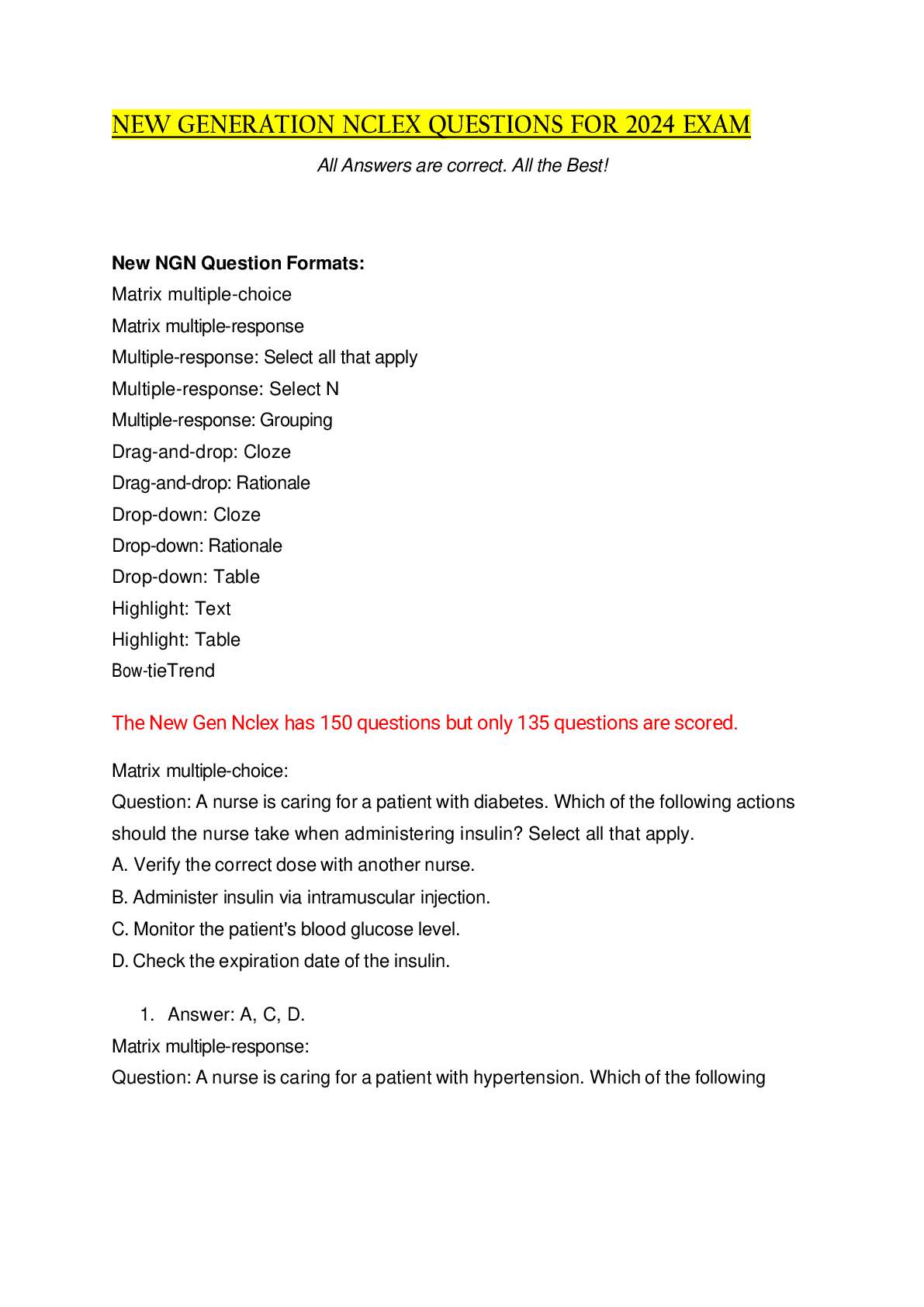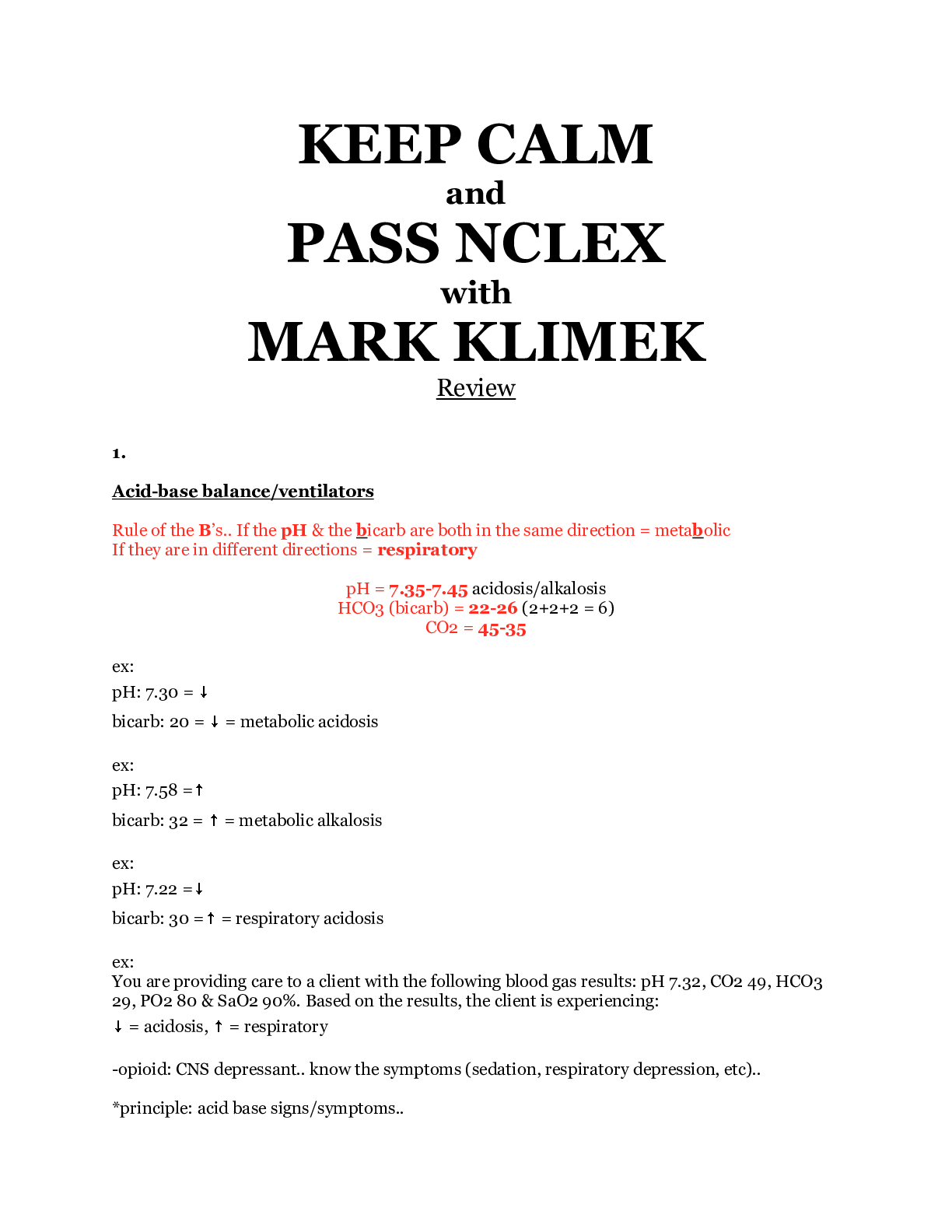*NURSING > NCLEX > University of South Alabama: NU 301 NCLEX Challenge 4 Questions and Answers,100% CORRECT (All)
University of South Alabama: NU 301 NCLEX Challenge 4 Questions and Answers,100% CORRECT
Document Content and Description Below
University of South Alabama: NU 301NCLEX Challenge 4 Questions and Answers NCLEX Challenge 4 1. A nurse is selecting a qualified staff member to double check a blood label with a client ID bracelet ... prior to infusing a unit of blood. The nurse should identify that which of the following persons is qualified? Oncology nurse 2. A nurse in an urgent care center is caring for a client who is having an acute asthma exacerbation. Which of the following actions is the nurse’s highest priority? Administering a nebulized beta-adrenergic 3. A nurse is auscultating the breath sounds of a client who has asthma. When the client exhales, the nurse hears continuous high-pitched squeaking sounds. The nurse should document this as which of the following adventitious breath sounds? Wheezes 4. A nurse is preparing to insert an IV catheter for a client and has selected the insertion site. Place the following steps in the order in which the nurse should perform them. Cleanse the site with an antiseptic swab Apply a tourniquet or BP cuff Dilate the vein Insert the catheter Flush the catheter 5. A nurse is teaching a client who has asthma how to use a metered- dose inhaler (MDI). The nurse identifies the sequence of steps the client should follow. Inhale deeply and then exhale completely Place her lips firmly around the mouthpiece Breathe in deeply over 2 to 3 seconds while pushing down on the canister Hold her breath for 10 seconds Exhale slowly through pursed lips Waited 60 seconds between each puff 6. A nurse is preparing to apply wrist restraints to a client to prevent her from pulling out an IV catheter. Which of the following actions should the nurse take? Keep the padded portion of the restraints against the wrists 7. A nurse is providing discharge teaching to a client who has asthma and new prescriptions for cromolyn and albuterol, both by nebulizer. Which of the following statements by the client indicates an understanding of the teaching? “I will be sure to take the albuterol before taking the cromolyn.” 8. A nurse is caring for a client who is confused and has pulled out her peripheral IV catheter three times. Which of the following actions should the nurse consider? Place mitten restraints on the client’s hands 9. A nurse is assessing a client prior to administering a seasonal influenza vaccine. The client says he read about an influenza vaccine that is given as a nasal spray and wants to receive it. The nurse should recognize that which of the following findings is a contraindication for a client receiving the live attenuated influenza vaccine (LAIV)? The client’s age is 62 10. A nurse is caring for a client who has chronic obstructive pulmonary disease (COPD). The client tells the nurse, “I can feel congestion in my lungs, and I certainly cough a lot, but I can’t seem to bring anything up.” Which of the following actions should the nurse take to help this client with tenacious bronchial secretions? Encouraging the client to drink 2 to 3 L of water daily 11. A nurse is instructing a client who is newly diagnosed with pulmonary tuberculosis (TB) about the use of antitubercular medications. Which of the following information should the nurse include in the teaching? A typical course of treatment involve 6 to 9 months of consistent medication use 12. A nurse is admitting a client who is having an exacerbation of his asthma. When reviewing the provider’s orders, the nurse recognizes that clarification is needed for which of the following medications? Propranolol 13. A nurse is caring for a client who has a central venous catheter and suddenly develops chest pain, dyspnea, dizziness, and tachycardia. The nurse suspects air embolism and clamps the catheter immediately. What other action should the nurse take at this time? Place the client on his left side in Trendelenburg position 14. A nurse is caring for a client who suspects recent exposure to inhalation anthrax. Which of the following findings indicate possible exposure? Flu-like symptoms 15. A nurse is collaborating on care for a client who has COPD. Which of the following tasks should the nurse recommend be referred to an occupational therapist for assistance? Instructing how to use kitchen tools to prepare a meal 16. A nurse in an emergency department is preparing to administer theophylline by continuous intravenous (IV) infusion to a client who is experiencing an asthma attack. Which of the following actions should the nurse take? Infuse the medication with an IV pump 17. A nurse is caring for a client who has advanced lung cancer. The client’s provider has recommended hospice services for the client. Which of the following statements by the client indicates a correct understanding of hospice care? “I should expect the hospice team to help me manage my dyspnea.” 18. A nurse is admitting a client who has pertussis. Which of the following types of transmission-based precautions should the nurse initiate? Droplet 19. A nurse is assessing a client who is receiving one unit of packed RBCs to treat intraoperative blood loss. The client reports chills and back pain, and the client’s blood pressure is 80/64 mm Hg. Which of the following actions should the nurse take first? Stop the infusion of blood 20. A nurse is preparing to insert a peripheral IV catheter. Which of the following antiseptics is the nurse’s best choice for preparing the client’s skin at the insertion site? Chlorhexidine 21. A nurse is teaching a client who has emphysema about self- management strategies. Which of the following statements by the client indicates an understanding of the teaching? “I will follow a daily diet high in calories and protein.” 22. A nurse is teaching a client who is about to undergo the insertion of a nontunneled central venous access device. Which of the following statements should the nurse identify as an indication that the client understands the instructions? “I will turn my head in the opposite direction during insertion.” 23. A nurse is teaching a client who has chronic obstructive pulmonary disease about ways to facilitate eating. Which of the following statements indicates a need for further teaching? “I will take my bronchodilators after meals.” 24. A nurse is assessing a client who has COPD. The nurse should expect the client’s chest to be which of the following shapes? Barrel 25. A nurse is caring for a client who has a central venous catheter and reports a gurgling sound on the side of the catheter insertion. Which of the following complications should the nurse suspect? Catheter migration 26. A nurse receives a unit of packed RBCs from a blood bank and notes that the time is 1130. The nurse should begin the infusion at which of the following times? As soon as the nurse can prepare the client and the administration set 27. A nurse is caring for a client who has a single lumen central venous catheter. Which of the following actions should the nurse take when accessing the catheter? Use a 10-mL syringe to flush the catheter 28. A nurse is assessing a client who has intravenous therapy-related phlebitis. The nurse uses the Infusion Nurses Society’s phlebitis scale to assess the severity of phlebitis and documents the client’s phlebitis as a grade level 1. Which of the following assessment findings correlates with a grade level of 1? Redness at the intravenous access site with pain 29. A nurse is assessing a client who has asthma. Which of the following areas should the nurse evaluate as the most reliable indicator of central cyanosis? Oral mucosa 30. A nurse is teaching a client who has been taking prednisone to treat asthma and has a new prescription to discontinue the medication. The nurse should explain to the client to reduce the dose gradually to prevent which of the following adverse effects? Adrenocortical insufficiency 31. A nurse is caring for a client who is receiving total parenteral nutrition via a peripherally inserted central catheter (PICC). When assessing the client, the nurse notes swelling of the client’s arm above the PICC insertion site. Which of the following actions should the nurse take first? Measure the circumference of both upper arms 32. A nurse is preparing a client for placement of a catheter for total parenteral nutrition. Which of the following access sites should the nurse plan to prepare for catheter insertion? Right subclavian vein 33. A nurse on a medical-surgical unit is performing an admission assessment of a client who has COPD with emphysema. The client reports that he has a frequent productive cough and is short of breath. The nurse should anticipate which of the following assessment findings for this client? Increased anteroposterior diameter of the chest 34. A nurse is preparing a client for outpatient surgery. After the nurse inserts the IV catheter, the client reports pain in the insertion area. Which of the following actions should the nurse take? Remove the catheter and insert another into a different site 35. A nurse is caring for a client who has emphysema. Which of the following findings should the nurse expect to assess in this client? (Select all that apply.) Dyspnea Barrel chest Clubbing of the fingers 36. A nurse is caring for a client following exposure to inhalational anthrax due to bioterrorism. Which of the following medications should the nurse expect as a common medication to treat anthrax? (Select all that apply.) Ciprofloxacin Doxycycline Amoxicillin 37. A nurse in a community health center is assessing the results of a tuberculin skin test she performed for a client. Which of the following results indicates exposure to and a possible infection with tuberculosis (TB)? 15 mm induration 38. A nurse is caring for a client who experienced an infection at the insertion site of her intravenous catheter. Which of the following findings should the nurse expect? Purulent drainage is noted from the site 39. A nurse is implementing a plan of care for a client who has AIDS with recurring pneumonia. Which of the following actions should the nurse take? Obtain a sputum culture 40. A nurse is admitting a client who has active tuberculosis to a room on a medical-surgical unit. Which of the following room assignments should the nurse make for the client? A room with air exhaust directly to the outdoor environment 41. A nurse is assessing a client who is to undergo a left lobectomy to treat lung cancer. The client tells the nurse that she is scared and wishes she had never smoked. Which of the following responses should the nurse make? “It’s okay to feel scared. Let’s talk about what you are afraid of.” 42. A nurse is teaching a client who has asthma about how to use an albuterol inhaler. Which of the following actions by the client indicates an understanding of the teaching? The client holds his breath for 10 seconds after inhaling the medication 43. A nurse is teaching a client who is to begin medicated treatment of tuberculosis. The nurse should instruct the client that which of the following herbal supplements can interact adversely with the treatment? Echinacea 44. A nurse is caring for a client who has a central venous catheter and develops acute shortness of breath. Which of the following actions should the nurse take first? Clamp the catheter 45. A nurse is developing a plan of care for a client who has COPD. The nurse should include which of the following interventions in the plan? Instruct the client to use pursed-lip breathing 46. A nurse is caring for a client who is to receive a unit of packed RBCs. The nurse should prime the blood administration tubing using which of the following IV solutions? 0.9% sodium chloride 47. A nurse is preparing to obtain a blood specimen from a client by venipuncture. The client is receiving IV fluids through an IV catheter inserted in the basilic vein of the right forearm. Which of the following sites should the nurse plan to use to obtain the blood specimen? Left forearm 48. A client has a right subclavian central venous catheter. When reconnecting a new administration set, which of the following instructions should the nurse give the client? “Bear down while holding breath.” 49. A nurse is caring for a client who has pneumonia. Which of the following actions should the nurse take to promote thinning of respiratory secretions? Encourage the client to increase fluid intake 50. A nurse is providing discharge teaching about nutrition to the parents of a child who has cystic fibrosis (CF). Which of the following responses by the parents indicates an understanding of the teaching? “We will give our child pancreatic enzymes with snacks and meals.” 51. A nurse is caring for a client who has active pulmonary tuberculosis (TB) and is to be started on intravenous rifampin therapy. The nurse should instruct the client that this medication can cause which of the following adverse effects? Body secretions turning a red-orange color 52. A nurse is caring for a client who has emphysema and has difficult with mobility. The client receives home health care and spends most of his day in a reclining chair. Which of the following physiological responses to prolonged immobility should the nurse expect? Increased calcium excretion 53. A nurse is inserting an IV catheter for an older client in preparation for an outpatient procedure. Which of the following veins should the nurse elect? Median vein in the forearm 54. A nurse in the emergency department is assessing an older adult client who has community-acquired pneumonia. Which of the following findings should the nurse expect? Confusion 55. A nurse is caring for a client and identifies an infiltration at the IV catheter site. Identify the order the nurse should perform the following actions. Stop the infusion Remove the IV catheter Apply a sterile dressing Elevate the extremity Apply warm or cold compresses 56. A nurse is planning care for a child who has cystic fibrosis and a prescription to receive chest physiotherapy (CPT). Which of the following actions should the nurse plan to take? Administer albuterol prior to CPT 57. A nurse is assessing a client who has pulmonary tuberculosis. Which of the following findings should the nurse expect? Lethargy 58. A nurse is attempting to flush the IV saline lock for a client. The client reports pain above the catheter site. Which of the following actions should the nurse take? Remove the IV saline lock 59. A nurse in a provider’s office is assessing an older adult client whose son reports that the client has been sick with a respiratory illness for the past 6 days. Which of the following assessment findings is a manifestation of pneumonia in the older adult client? Confusion 60. A nurse is caring for a client who has lung cancer and is scheduled for a lobectomy. The nurse should prepare the client to expect which of the following after the procedure? A chest tube [Show More]
Last updated: 1 year ago
Preview 1 out of 19 pages

Reviews( 0 )
Document information
Connected school, study & course
About the document
Uploaded On
Aug 02, 2022
Number of pages
19
Written in
Additional information
This document has been written for:
Uploaded
Aug 02, 2022
Downloads
0
Views
46

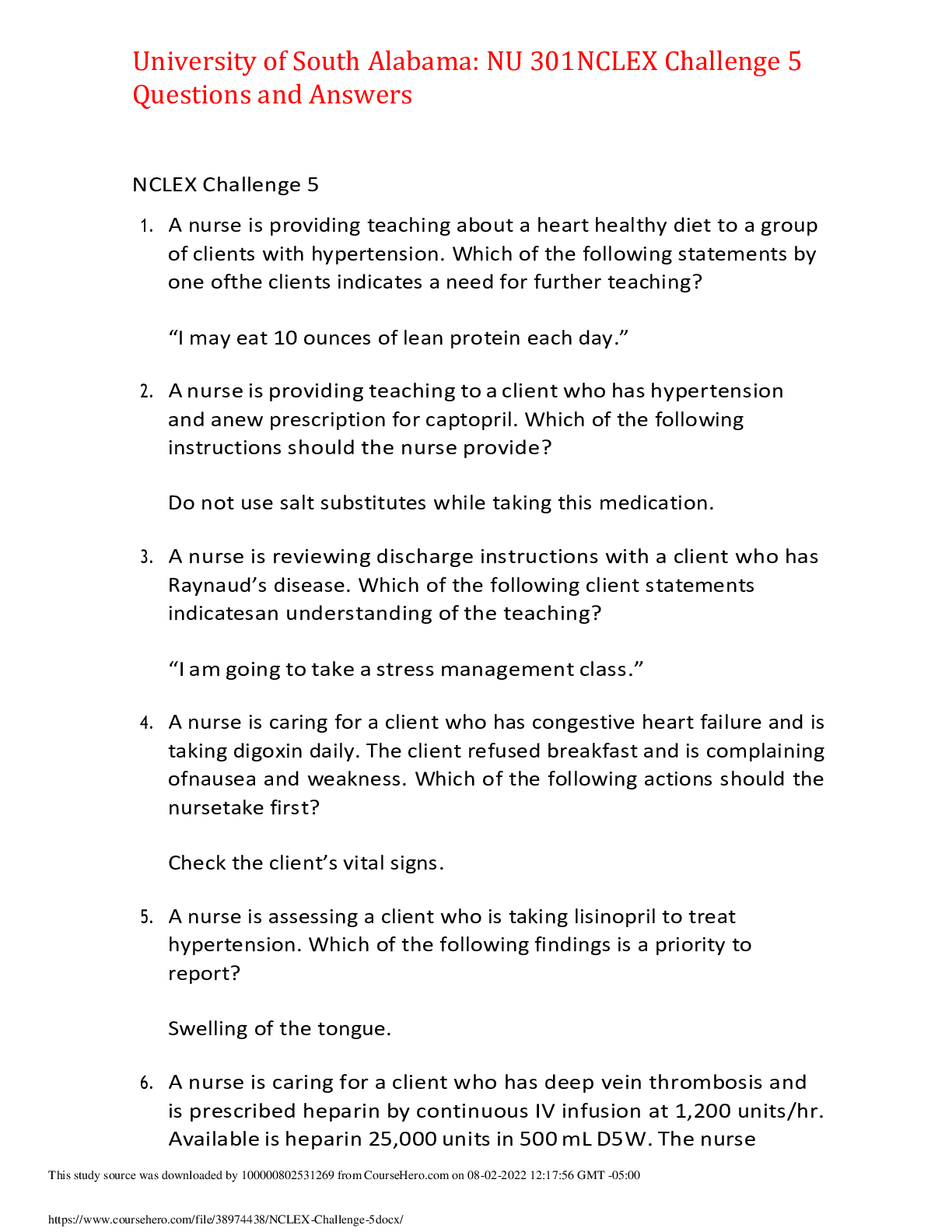
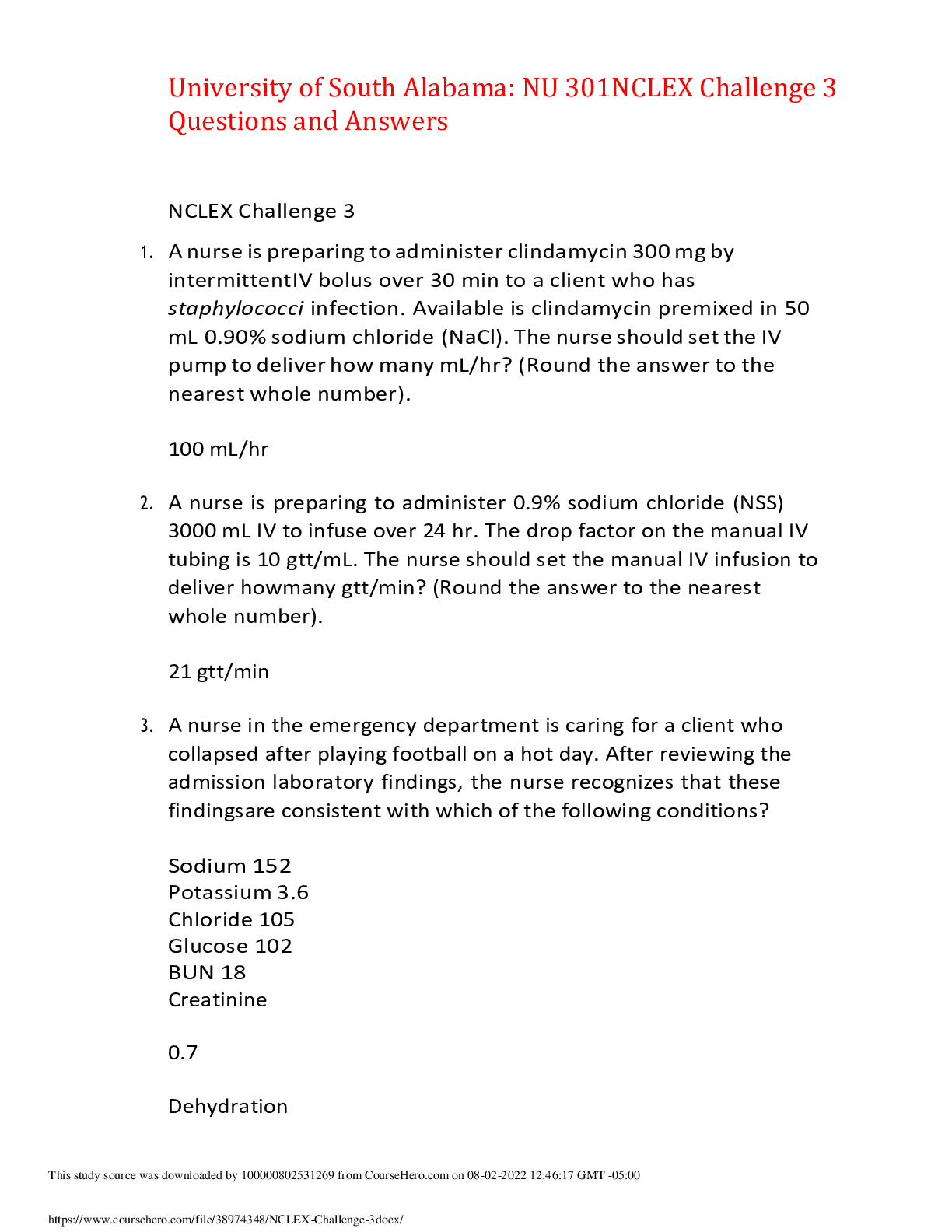
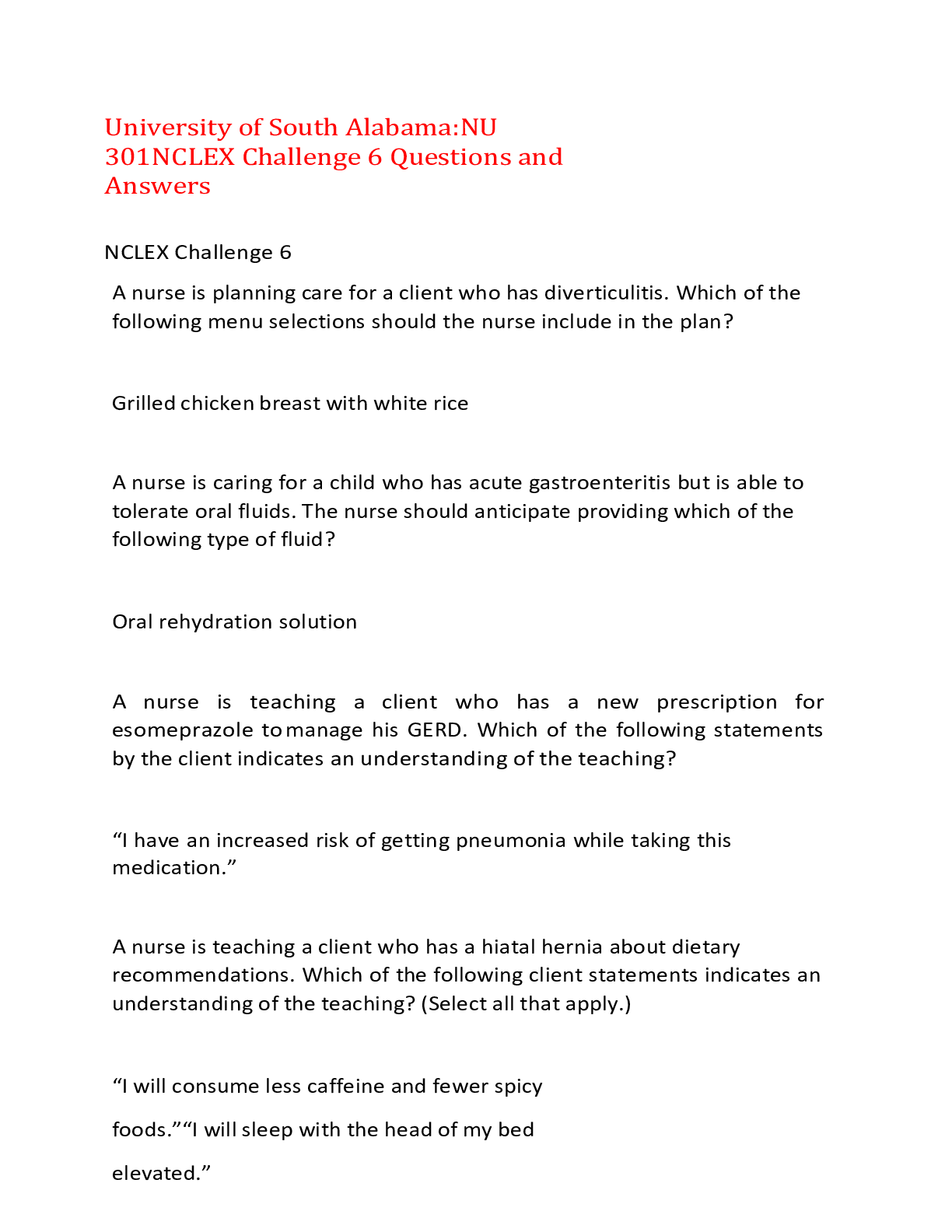
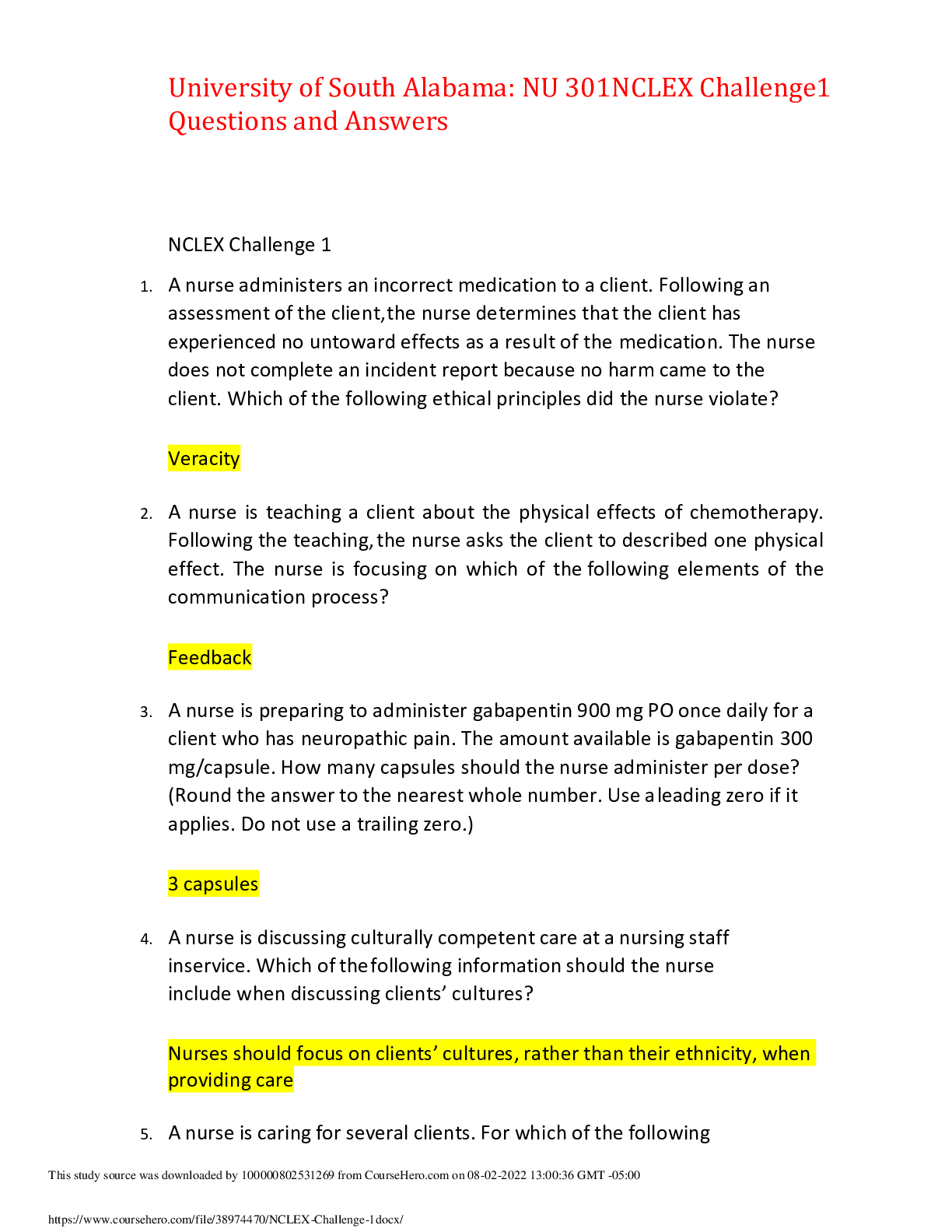

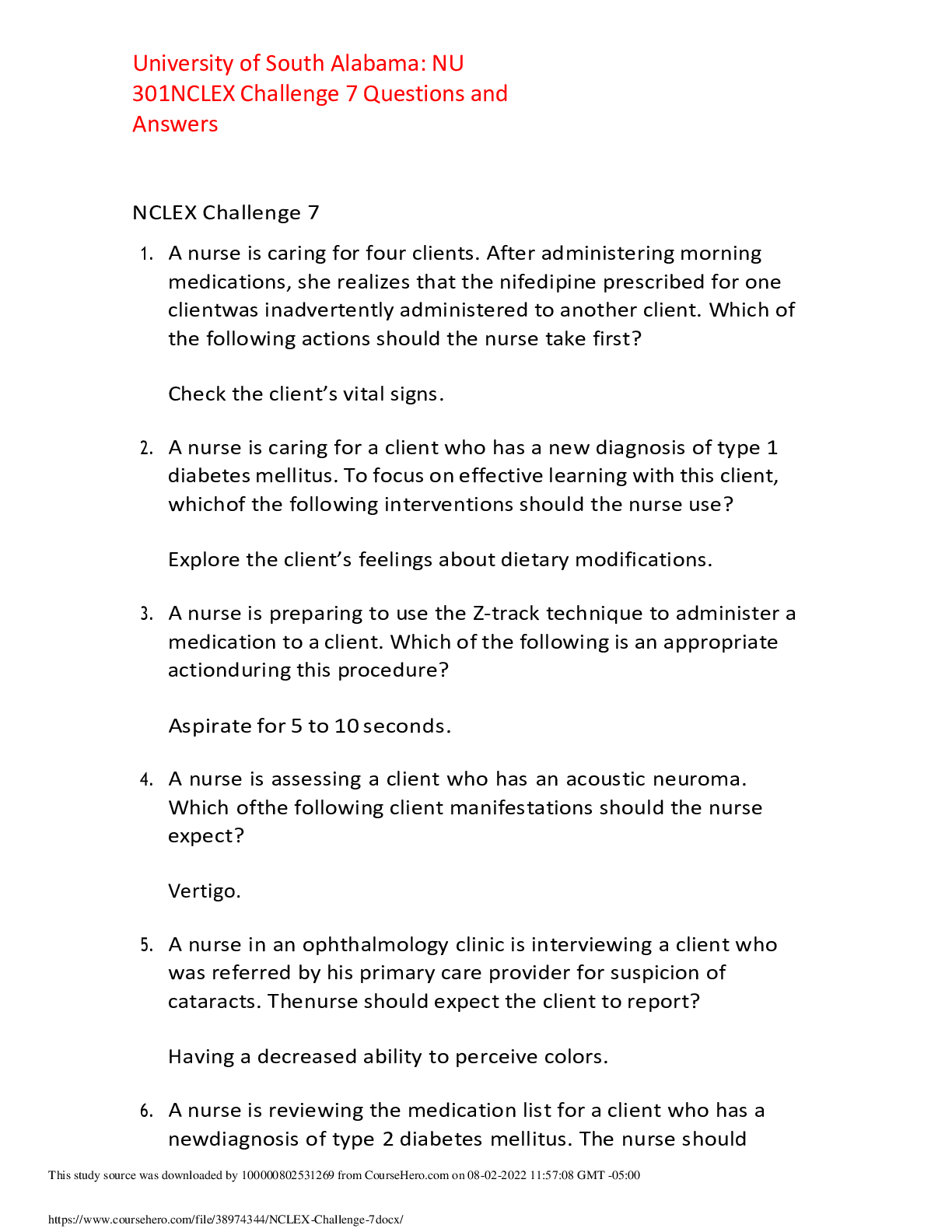
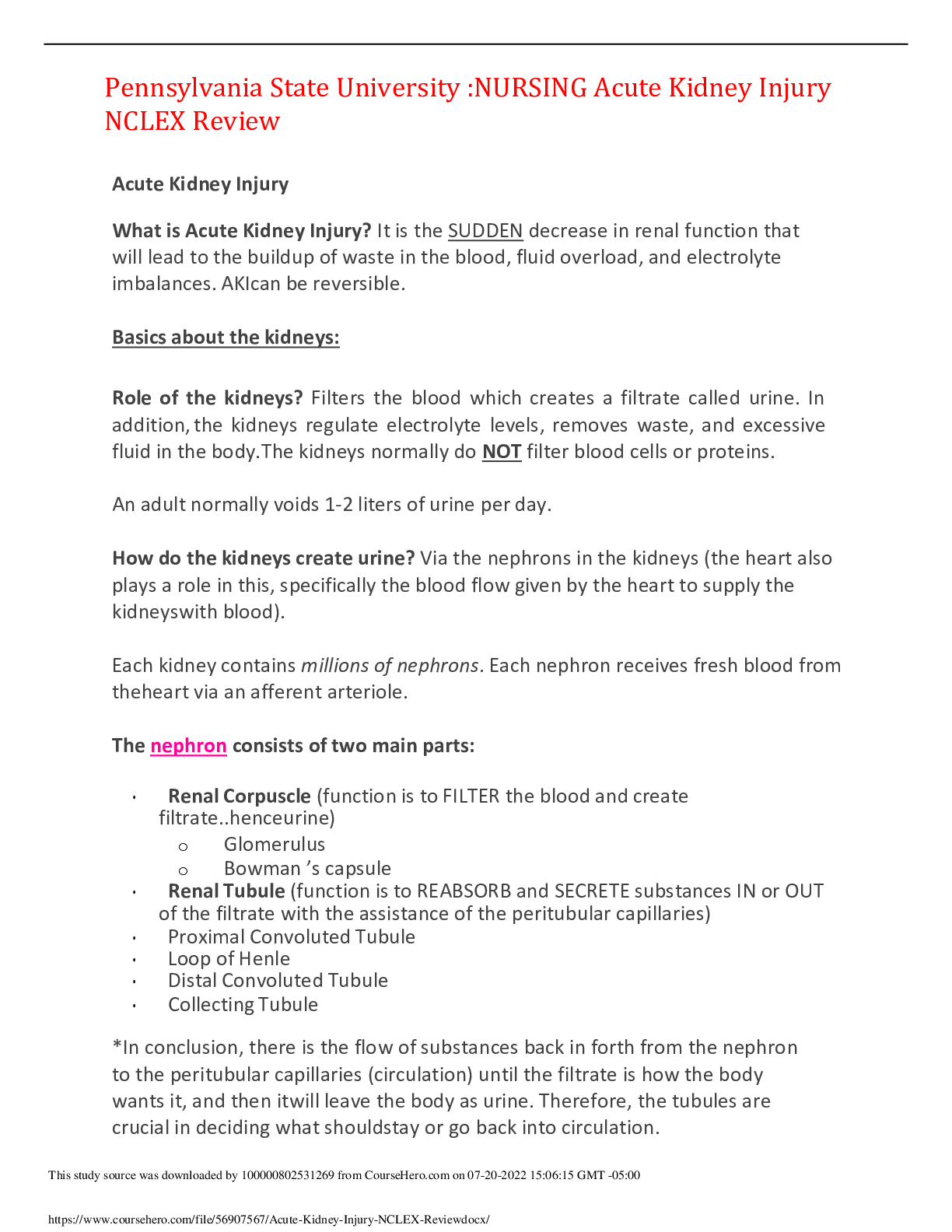
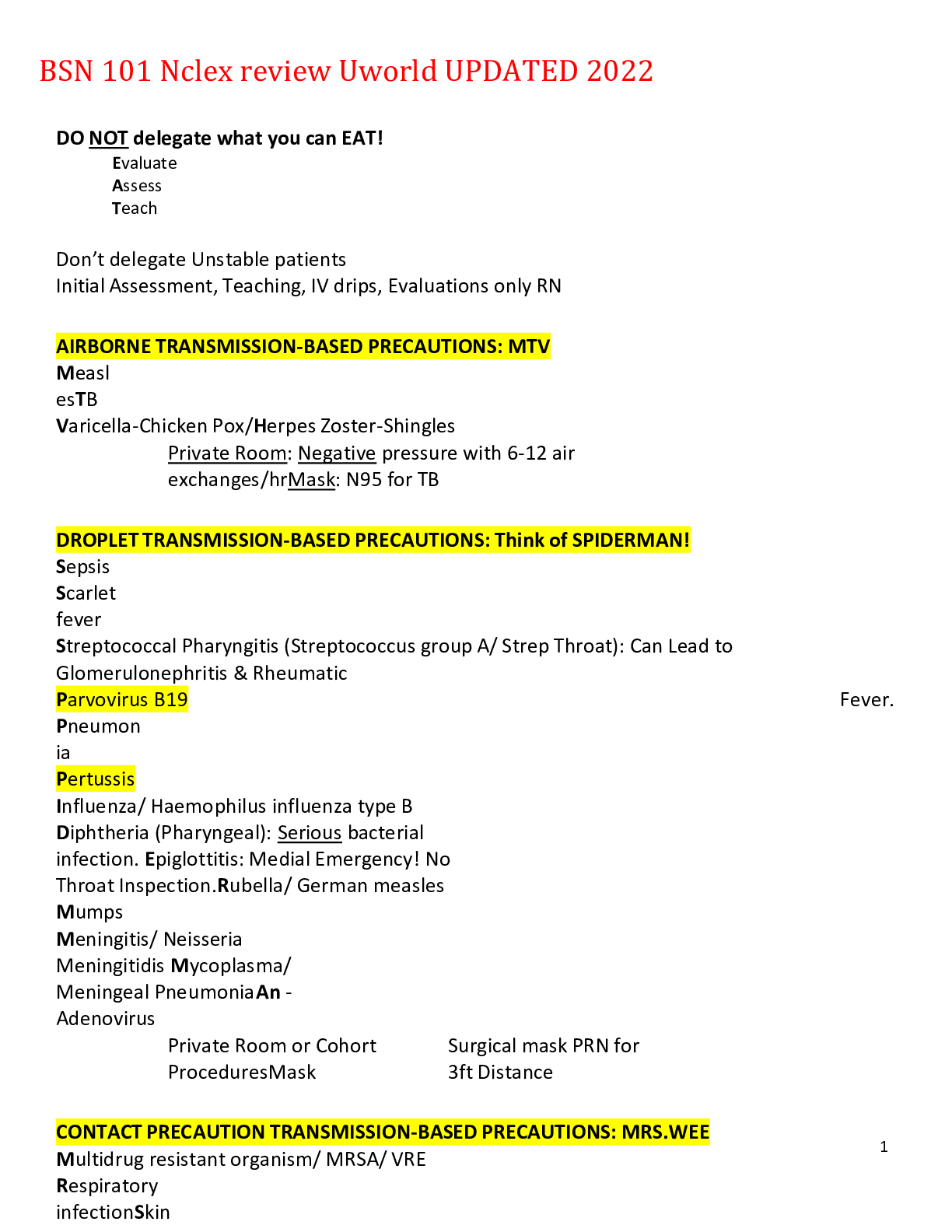
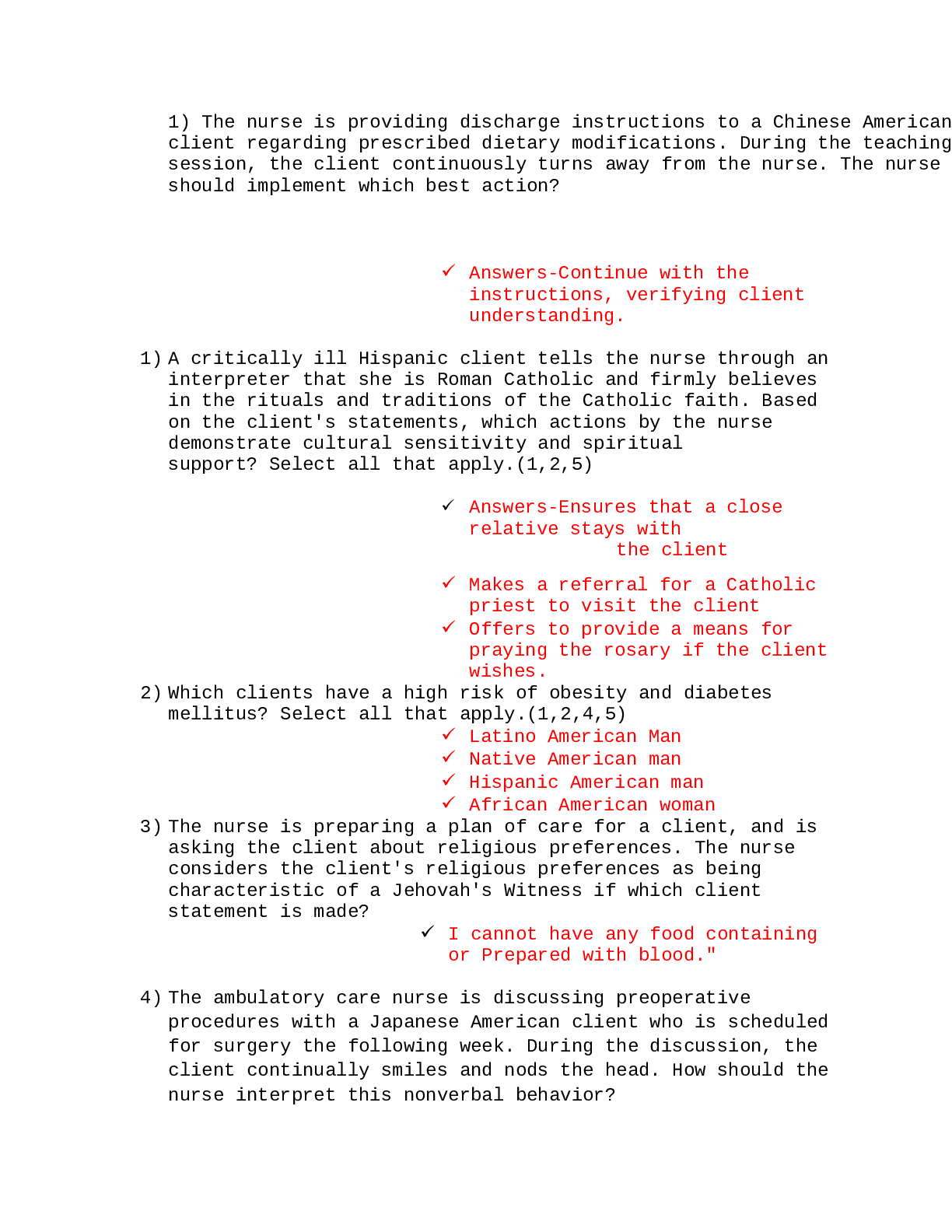
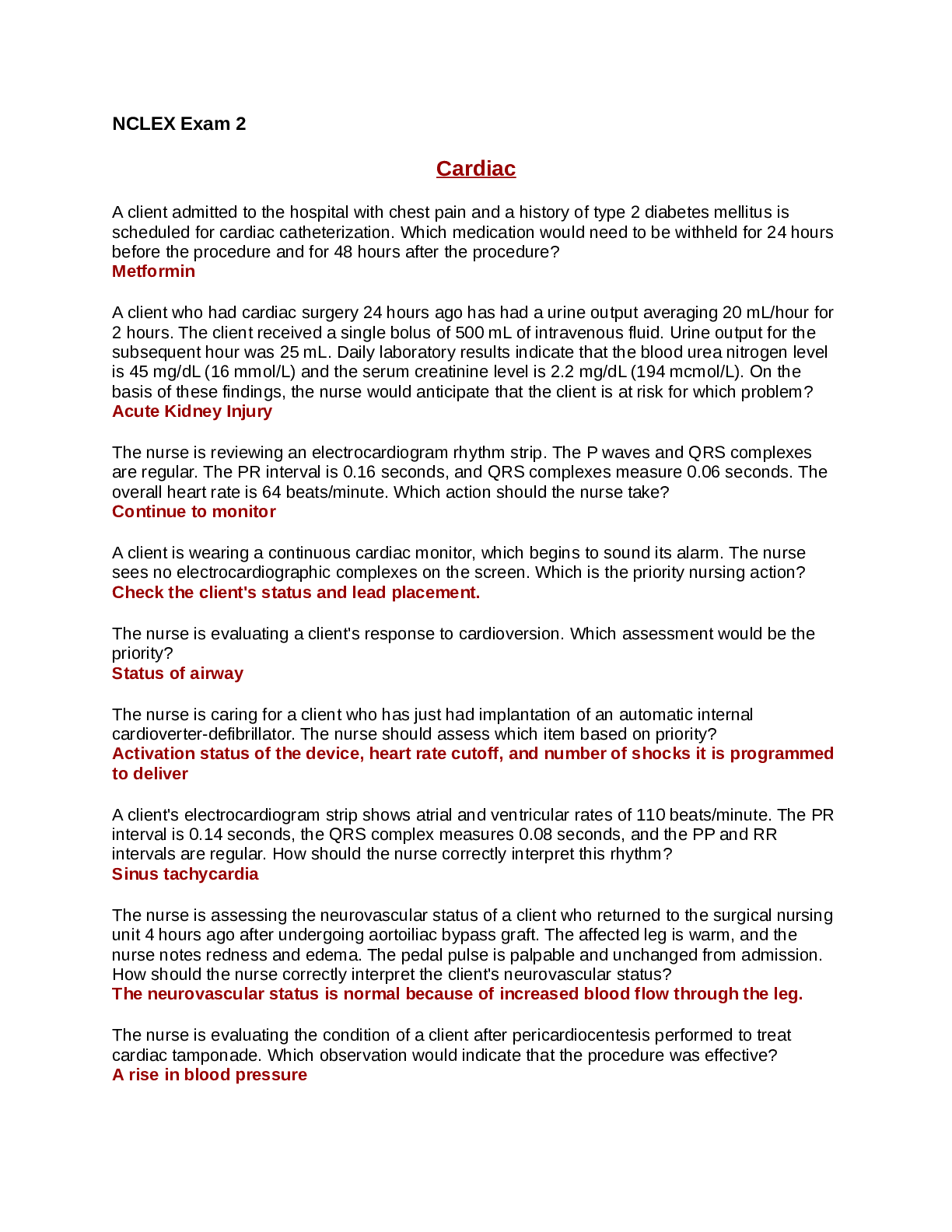
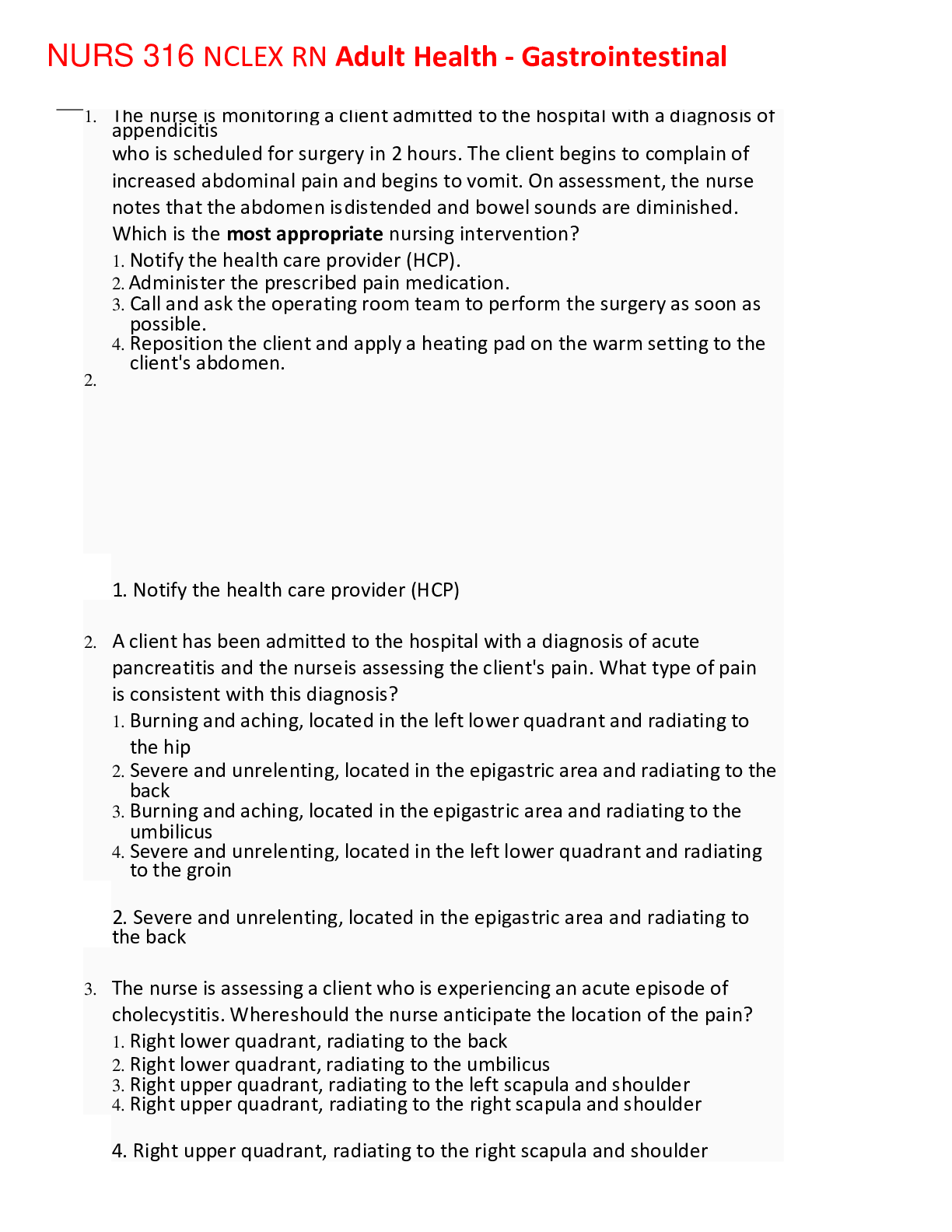
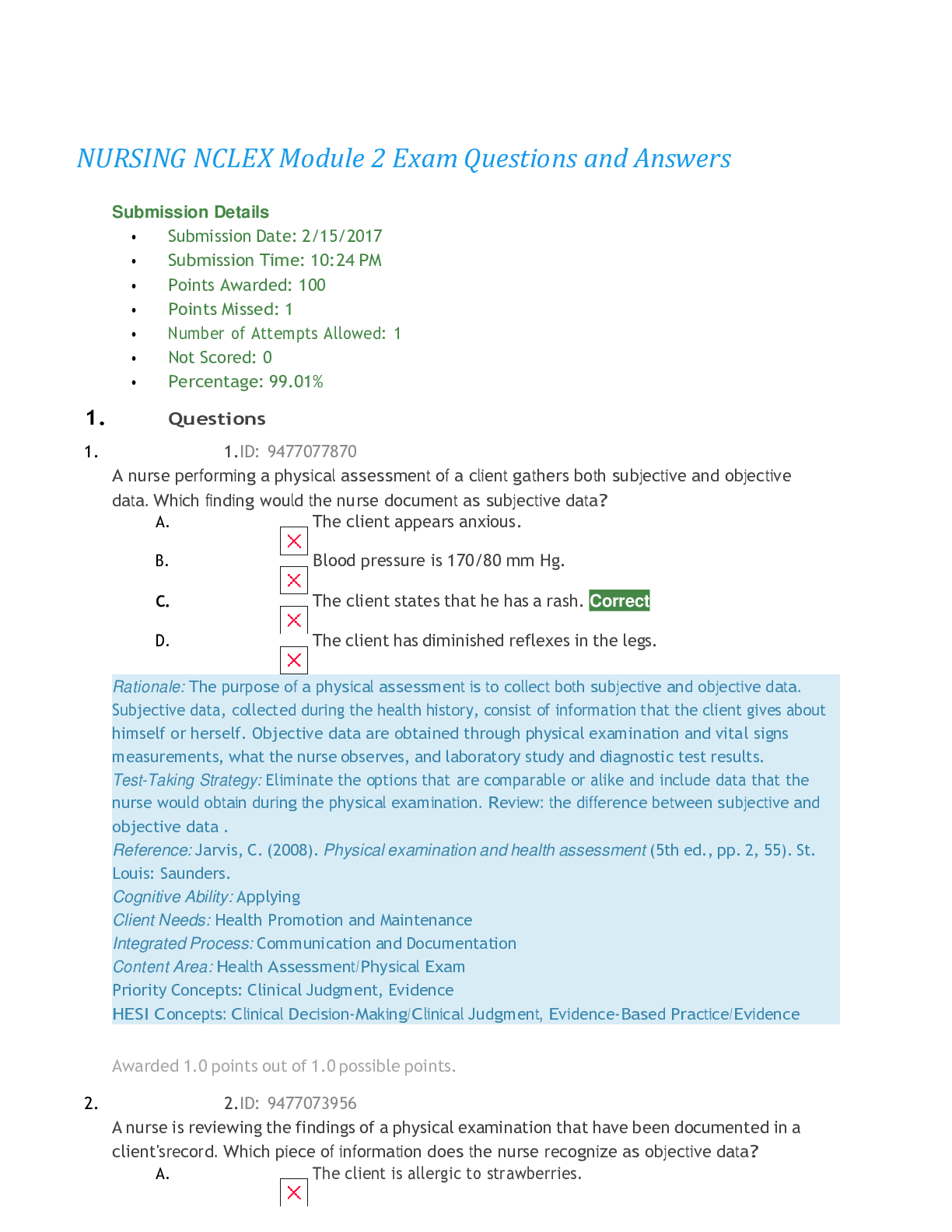
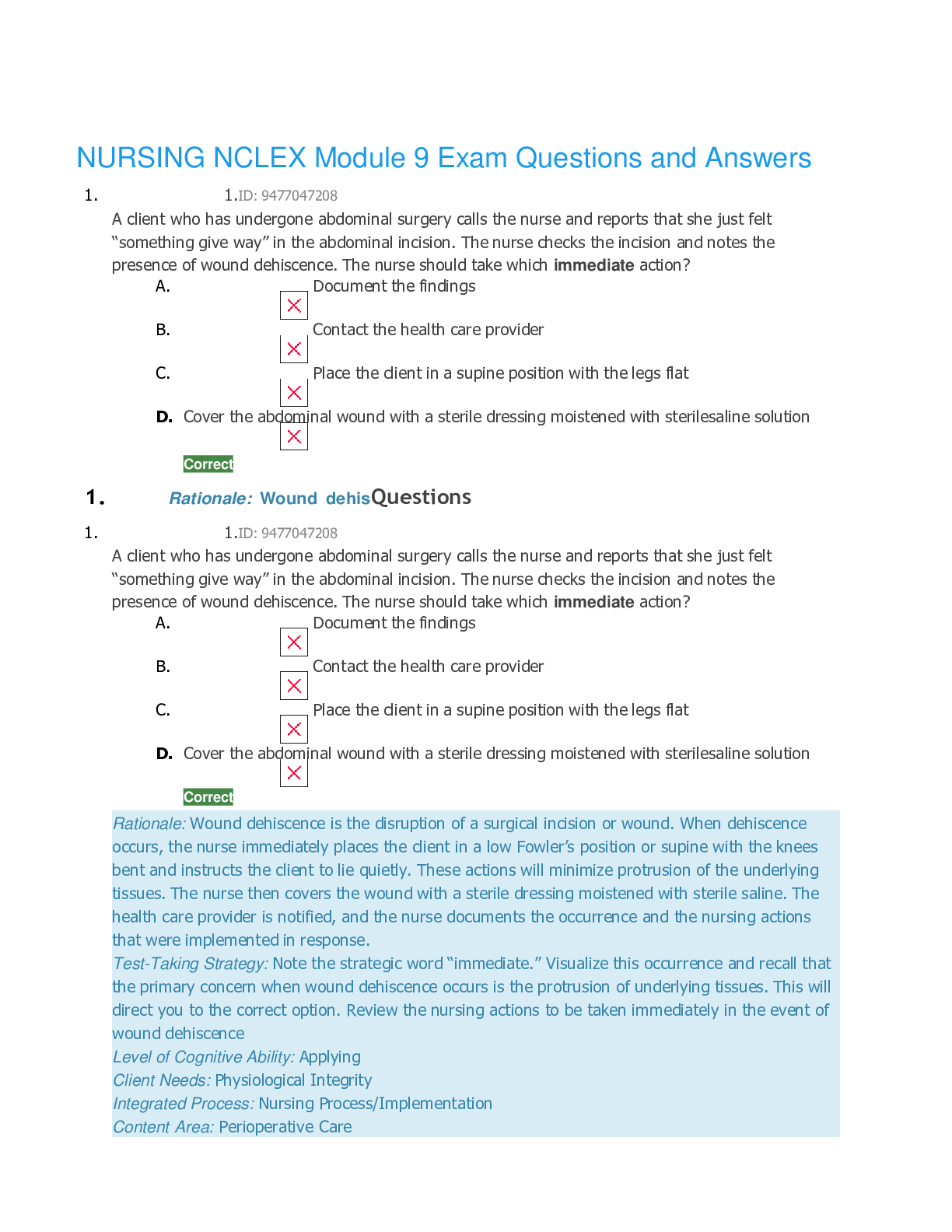
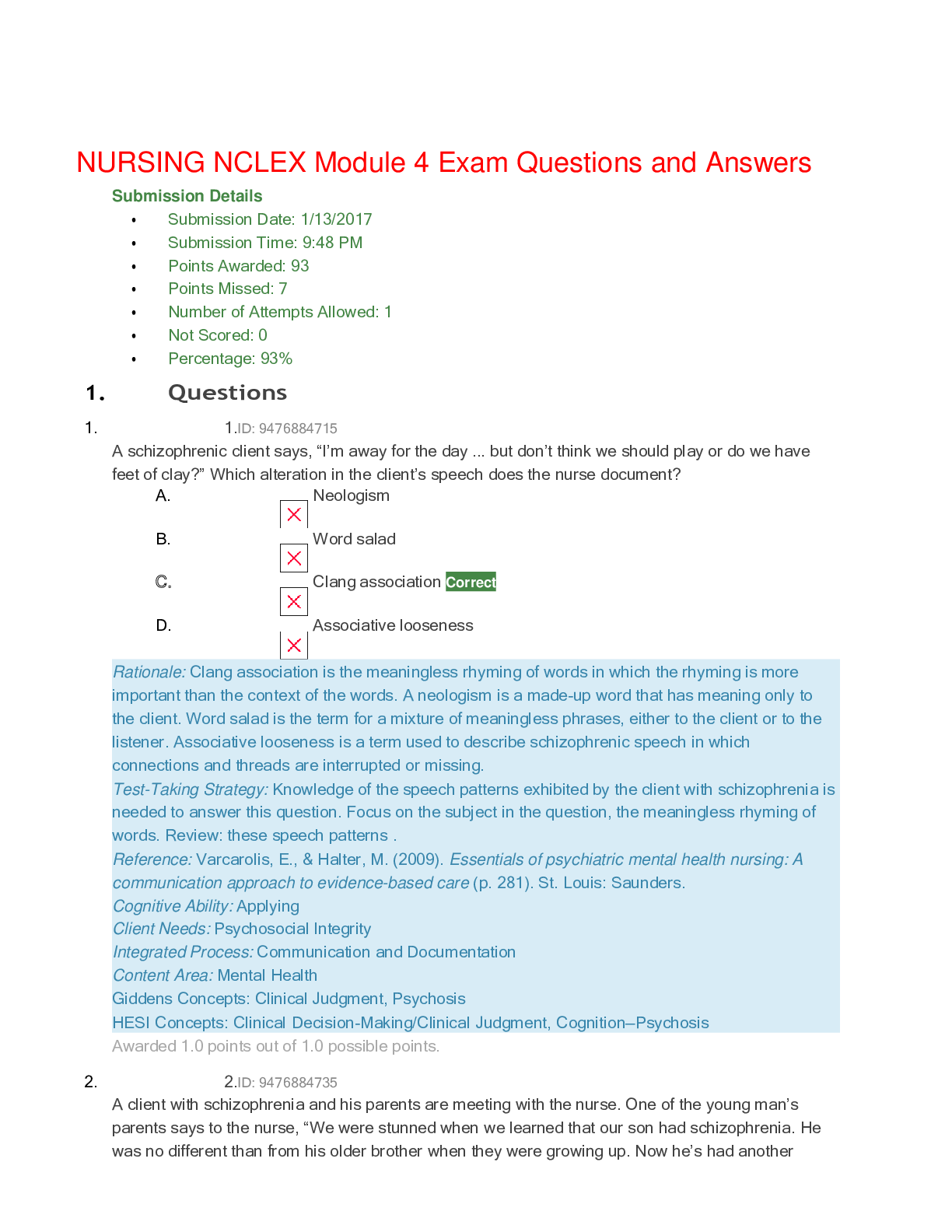


 Questions and answers – Keiser University.png)


